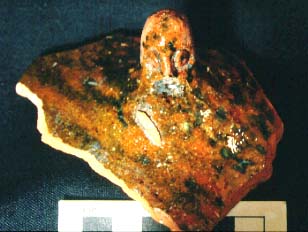 |
Late Medieval and Transitional Ware
Site: Dragon Hall, Norwich.
Period: Late Medieval (15th-16th centuries AD).
Excavator: Norfolk Archaeological Unit.
Published: Anderson forthcoming.
Brief description: Pottery was produced in several parishes along the Waveney Valley and north-central Suffolk during the 15th to 16th centuries. Kilns have been excavated at Hopton (above) and Rickinghall. All sites produced pale redwares (really buff to orange) with partial green glazes in a wider range of forms than had previously been manufactured by rural potteries. Jugs, bowls and jars were still made, but to these were added bunghole cisterns, dripping and fish dishes, large bowls (pancheons) for use in dairying, and pipkins and skillets for cooking. The example shown here is a lid with a small applied face. It is a transitional form between the medieval use of applied face decoration and the plainer forms of the post-medieval period.
Further reading
Anderson, S., Breen, A., Caruth, J. and Gill, D., 1996, 'The late medieval pottery industry on the North Suffolk border', Medieval Ceramics 20.
Jennings, S., 1981, Eighteen Centuries of Pottery from Norwich, East Anglian Archaeology 13. |